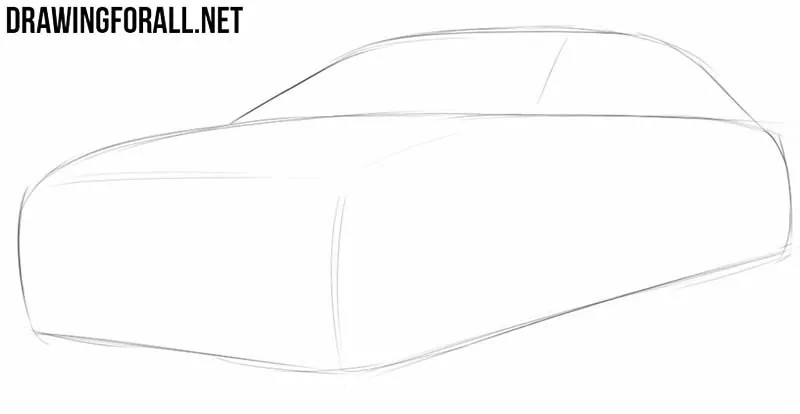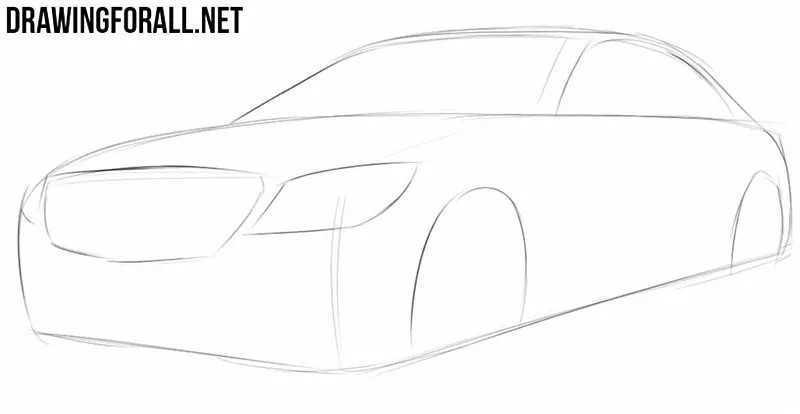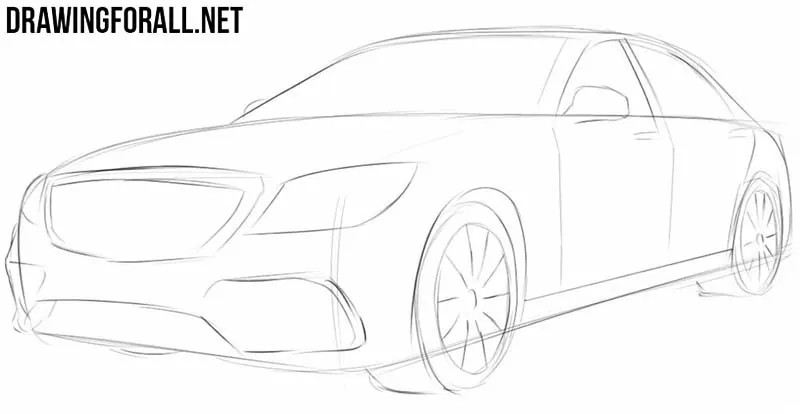Learning How To Draw A Car Steps can be an enjoyable and rewarding experience, and at CARS.EDU.VN, we’re here to guide you through each stage of creating your automotive artwork, regardless of your skill level. This detailed guide will provide you with a structured method to drawing cars, covering everything from the basics to more sophisticated details. Discover expert advice and practical tips to elevate your car drawing skills. Whether it’s vehicle sketching techniques, auto illustration tutorials, or transportation design tips.
1. Understanding the Basics of Car Design
Before diving into the drawing process, it’s essential to grasp the foundational elements of car design. This knowledge will greatly enhance the realism and appeal of your drawings.
1.1. Key Elements of Automotive Design
Understanding car proportions is vital. A typical car consists of the hood, cabin, and trunk. Familiarize yourself with various car body styles such as sedans, SUVs, and sports cars, each having distinct proportions. The wheelbase—the distance between the front and rear axles—influences the car’s overall design.
| Element | Description |
|---|---|
| Proportions | The relative size and scale of different parts of the car, such as the hood, cabin, and trunk. |
| Body Styles | Different types of car designs, including sedans, SUVs, sports cars, and trucks, each with its unique shape and dimensions. |
| Wheelbase | The distance between the front and rear axles, which affects the car’s stability and appearance. |
| Design Language | The consistent use of design elements and themes that define a car brand’s identity. Brands like BMW, Mercedes-Benz, and Audi have distinct design languages that make their cars easily recognizable. Each brand’s design philosophy dictates the lines, shapes, and overall aesthetic of their vehicles. |
| Aerodynamics | The study of how air flows around the car, influencing its shape to reduce drag and improve fuel efficiency. |
| Surface Detailing | The subtle curves, creases, and lines that add character and visual interest to the car’s body. Surface detailing includes elements like door handles, side mirrors, and trim. These elements are carefully integrated into the overall design to enhance the car’s aesthetic appeal without compromising its aerodynamic performance or functionality. |
1.2. Essential Tools and Materials
Gather the right tools to set yourself up for success. Essential supplies include:
- Pencils: Use a range of hardnesses, such as 2H for light sketching and 2B or 4B for darker lines.
- Paper: Opt for smooth drawing paper that can handle erasing and multiple layers.
- Erasers: A kneaded eraser is excellent for lifting graphite, and a plastic eraser is useful for clean erasures.
- Rulers and Templates: These tools help create straight lines and consistent shapes.
1.3. Understanding Perspective in Car Drawings
Perspective is crucial for creating realistic car drawings. One-point perspective is ideal for simple side views, while two-point perspective is better for showing the car from an angle, providing depth and realism. Three-point perspective is used for dynamic, dramatic angles, but it is more complex.
2. Step-by-Step Guide: Drawing a Car
Follow these detailed steps to draw a car, suitable for both beginners and experienced artists.
2.1. Step 1: Basic Outline
Begin by sketching the basic shape of the car using light pencil strokes. This establishes the car’s overall form and proportions. Focus on getting the main body lines correct before adding details. Sketch the hood, cabin, and trunk lightly.
2.2. Step 2: Adding Key Features
Next, add the most prominent features like the headlights, grille, and wheel arches. Pay attention to their placement and size relative to the overall car body. Lightly sketch window outlines to define the cabin area.
2.3. Step 3: Refining the Details
Start adding more details such as air intakes, side mirrors, and the B-pillar (the support between the front and rear windows). Sketch the wheels inside the wheel arches using smooth lines.
2.4. Step 4: Doors and Additional Lines
Sketch the doors and door handles. Lightly add the pattern of the rims on the wheels. Refine the details of the grille and air intakes to add more definition.
2.5. Step 5: Tracing the Front
Use darker lines to trace and correct the front of the car. Add details to the headlights, license plate area, and refine the grille and air intakes. Ensure the lines are neat and precise.
2.6. Step 6: Detailing the Top
Detail the top of the car, including the roof, windows, and side mirrors. Use clear, dark lines to define these features. Erase any unnecessary construction lines.
2.7. Step 7: Side Surface Details
Focus on detailing the side surface of the car and the visible part of the trunk. Add details to the door handles and include any decorative lines or features on the body.
2.8. Step 8: Wheels and Rims
Carefully draw the wheels and rims. Ensure the wheels are round and the spokes are evenly spaced. This step requires attention to detail to achieve a realistic look.
2.9. Step 9: Adding Shadows
Add shadows to give the car a three-dimensional appearance. Use hatching techniques to create depth and volume, following the contours of the car’s body. Adjust the density of the hatching to reflect light and shadow.
3. Advanced Techniques for Car Drawing
Once you’ve mastered the basics, explore advanced techniques to elevate your car drawings.
3.1. Mastering Light and Shadow
Understanding how light interacts with surfaces is crucial for creating realistic drawings. Observe how light reflects off different parts of the car and use shading techniques to replicate these effects.
3.2. Rendering Techniques
Rendering involves adding tonal values to your drawing to create a sense of depth and form. Experiment with techniques like blending, hatching, and stippling to achieve different effects.
3.3. Adding Reflections
Reflections enhance realism by simulating how light bounces off the car’s surfaces. Pay attention to the environment and include reflections of surrounding objects in your drawing.
4. Drawing Different Car Types
Different car types require different approaches due to their unique shapes and proportions.
4.1. Drawing Sports Cars
Sports cars are characterized by their sleek, aerodynamic designs. Emphasize the curves and dynamic lines that define their appearance. Lower ride height and aggressive stances are crucial elements.
4.2. Drawing SUVs
SUVs have a more robust, boxy shape. Focus on their height and strong lines to capture their commanding presence. Highlight the large wheels and high ground clearance.
4.3. Drawing Classic Cars
Classic cars often feature unique design elements and vintage details. Research specific models to accurately represent their distinctive characteristics, such as chrome trim, round headlights, and unique body shapes.
5. Common Mistakes and How to Avoid Them
Even experienced artists make mistakes. Here are some common pitfalls to avoid:
5.1. Proportions
Inaccurate proportions can make your drawing look unrealistic. Always double-check measurements and compare them to reference images.
5.2. Perspective
Incorrect perspective can distort the car’s appearance. Practice perspective drawing regularly to improve your skills.
5.3. Details
Rushing through details can lead to sloppy results. Take your time and pay attention to every element, no matter how small.
6. Tips for Improving Your Car Drawing Skills
Consistent practice and a willingness to learn are key to improving your car drawing skills.
6.1. Practice Regularly
Set aside time each day or week to practice drawing cars. Consistent effort will lead to significant improvement over time.
6.2. Use Reference Images
Reference images are invaluable for accurately representing car designs. Use them to study proportions, details, and shading.
6.3. Take Online Courses
Online courses offer structured lessons and expert guidance. CARS.EDU.VN provides links to various resources to enhance your knowledge and skills.
7. The Role of Technology in Car Drawing
Technology has transformed the way cars are designed and drawn.
7.1. Digital Drawing Tools
Digital drawing tools such as tablets and styluses offer a range of benefits, including ease of editing, layering, and experimenting with different techniques.
7.2. CAD Software
CAD (Computer-Aided Design) software is used by professional designers to create precise, detailed car models. While complex, learning CAD can greatly enhance your design capabilities.
7.3. 3D Modeling
3D modeling allows you to create virtual car models that can be viewed from any angle. This is a powerful tool for visualizing and refining car designs.
8. Learning Resources at CARS.EDU.VN
CARS.EDU.VN offers a wealth of resources to help you learn about car drawing and automotive design.
8.1. Tutorials and Guides
We provide detailed tutorials and guides on various aspects of car drawing, from basic techniques to advanced rendering.
8.2. Expert Articles
Our expert articles cover a wide range of topics, including car design history, emerging technologies, and interviews with leading designers.
8.3. Community Forum
Join our community forum to connect with other artists, share your work, and get feedback.
9. The Art of Car Sketching
Car sketching is a fundamental skill for automotive designers and enthusiasts.
9.1. Quick Sketching Techniques
Learn how to quickly capture the essence of a car’s design using gesture drawing and simplified lines.
9.2. Developing Ideas Through Sketching
Use sketching to explore different design ideas and refine your concepts.
9.3. Sketching from Observation
Practice sketching cars from real life to improve your observational skills and understanding of form.
10. Drawing Cars from Different Angles
Drawing cars from different angles can be challenging, but it’s essential for creating dynamic and engaging compositions.
10.1. Front View
The front view emphasizes the car’s face and grille. Pay attention to symmetry and proportion.
10.2. Side View
The side view is ideal for showcasing the car’s overall shape and lines. Focus on the silhouette and wheelbase.
10.3. Three-Quarter View
The three-quarter view offers a balanced perspective, showing both the front and side of the car. This is a popular choice for automotive illustrations.
11. Showcasing Car Features Through Drawing
Highlighting specific car features can add interest and detail to your drawings.
11.1. Wheels and Rims
Detailed wheels and rims can significantly enhance the car’s appearance. Pay attention to the design of the spokes, the depth of the rims, and the tire tread.
11.2. Headlights and Taillights
Headlights and taillights are distinctive features that can define a car’s personality. Accurately represent their shape and design.
11.3. Grilles and Badges
Grilles and badges are key branding elements. Capture their details to accurately represent the car’s make and model.
12. Understanding Car Aerodynamics for Drawing
Understanding aerodynamics can help you draw cars with more realism and accuracy.
12.1. Aerodynamic Features
Learn about aerodynamic features such as spoilers, diffusers, and air intakes.
12.2. Streamlining
Understand how streamlining affects the car’s shape and lines.
12.3. Drawing Airflow
Consider drawing airflow lines to visualize how air moves around the car.
13. The Future of Car Drawing and Design
The future of car drawing and design is being shaped by technology and changing consumer preferences.
13.1. Emerging Technologies
Explore emerging technologies such as virtual reality (VR) and augmented reality (AR).
13.2. Sustainable Design
Learn about sustainable design principles and how they are influencing car design.
13.3. Electric Vehicles
Understand the design considerations for electric vehicles (EVs).
14. Where to Find Inspiration for Car Drawings
Inspiration can come from many sources.
14.1. Car Shows
Attend car shows to see the latest models and designs.
14.2. Automotive Magazines
Read automotive magazines to stay up-to-date on industry trends and new car releases.
14.3. Online Galleries
Browse online galleries to see the work of other artists and designers.
15. Building a Portfolio of Car Drawings
A strong portfolio is essential for showcasing your skills and attracting clients or employers.
15.1. Selecting Your Best Work
Choose your best drawings to include in your portfolio.
15.2. Organizing Your Portfolio
Organize your portfolio in a clear and professional manner.
15.3. Showcasing Your Skills
Highlight your skills and strengths in your portfolio.
16. Connecting with the Car Drawing Community
Connecting with other artists can provide support, inspiration, and opportunities for collaboration.
16.1. Online Forums
Participate in online forums to share your work and get feedback.
16.2. Social Media
Use social media to connect with other artists and showcase your work.
16.3. Local Art Groups
Join local art groups to meet other artists in person.
17. The Importance of Car Detailing in Drawings
Car detailing is crucial for adding realism and visual interest to your drawings.
17.1. Small Details
Pay attention to small details such as door handles, mirrors, and emblems.
17.2. Material Representation
Accurately represent different materials such as metal, glass, and plastic.
17.3. Textures
Add textures to your drawings to enhance realism.
18. How to Draw Realistic Car Reflections
Drawing realistic car reflections can significantly enhance the realism of your drawings.
18.1. Understanding Reflection Principles
Understand the principles of reflection and how light bounces off surfaces.
18.2. Representing Reflections
Use shading and highlights to represent reflections accurately.
18.3. Adding Environmental Elements
Include environmental elements in your reflections to add realism.
19. Tips for Drawing Car Interiors
Drawing car interiors can be challenging, but it’s essential for creating complete and detailed car drawings.
19.1. Interior Components
Familiarize yourself with the components of a car interior, such as the dashboard, seats, and steering wheel.
19.2. Perspective
Use perspective to accurately represent the interior space.
19.3. Detailing
Add details such as stitching, textures, and reflections to enhance realism.
20. Creating Dynamic Compositions in Car Drawings
Creating dynamic compositions can make your car drawings more engaging and visually appealing.
20.1. Angle Selection
Choose angles that showcase the car’s best features.
20.2. Movement
Incorporate elements of movement into your compositions.
20.3. Backgrounds
Use backgrounds to add context and depth to your drawings.
At CARS.EDU.VN, we understand the challenges enthusiasts and professionals face when seeking reliable car care, repair information, and design inspiration. You might struggle to find trustworthy service providers, lack essential maintenance knowledge, or feel overwhelmed when choosing the right vehicle.
We’re here to help. CARS.EDU.VN is your ultimate resource for detailed service information, maintenance guides, expert car reviews, and the latest automotive technology news. Whether you need to understand routine maintenance, troubleshoot issues, or stay updated on industry innovations, we provide clear and actionable insights to keep you informed and confident.
Ready to elevate your car knowledge and skills? Visit CARS.EDU.VN today for exclusive content, expert advice, and a supportive community. Your journey to becoming a car expert starts here.
Contact us:
- Address: 456 Auto Drive, Anytown, CA 90210, United States
- WhatsApp: +1 555-123-4567
- Website: cars.edu.vn
Frequently Asked Questions (FAQ)
1. What are the basic tools needed to start drawing cars?
Essential tools include pencils (2H, 2B, 4B), smooth drawing paper, kneaded and plastic erasers, and rulers or templates.
2. How important is perspective in car drawing?
Perspective is crucial for creating realistic and proportional car drawings.
3. What is the best way to improve my car drawing skills?
Consistent practice, using reference images, and taking online courses are effective ways to improve.
4. Can digital drawing tools enhance car drawing?
Yes, digital drawing tools offer benefits such as easy editing, layering, and experimentation with techniques.
5. What are some common mistakes to avoid in car drawing?
Common mistakes include inaccurate proportions, incorrect perspective, and rushing through details.
6. How can I add realism to my car drawings?
Add realism by mastering light and shadow, using advanced rendering techniques, and including reflections.
7. What are the key features of a sports car to emphasize in a drawing?
Emphasize sleek curves, dynamic lines, lower ride height, and an aggressive stance.
8. How do I draw car interiors effectively?
Familiarize yourself with interior components, use perspective accurately, and add details such as stitching and textures.
9. Where can I find inspiration for car drawings?
Find inspiration at car shows, in automotive magazines, and through online galleries.
10. What role does aerodynamics play in car drawing?
Understanding aerodynamics helps you draw cars with more realism and accuracy by considering features like spoilers and streamlining.









